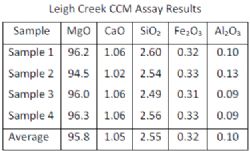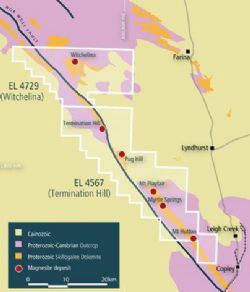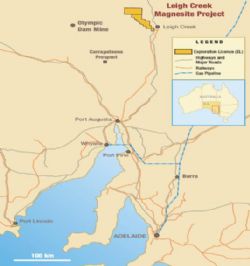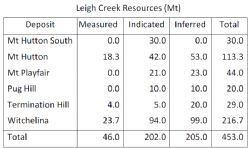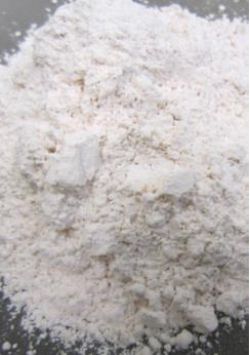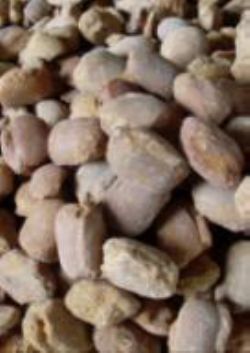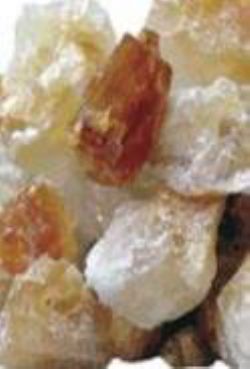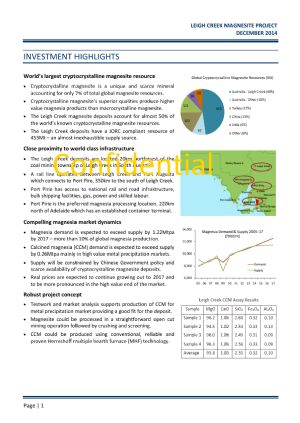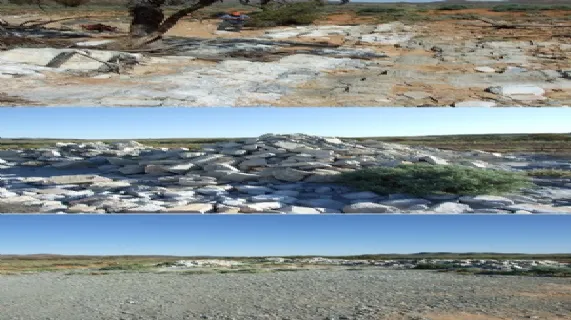
Cryptocrystalline Magnesite Resource
Sydney, Dec 15, 2014 AEST (ABN Newswire) - Leigh Creek is the World's largest cryptocrystalline magnesite resource
- Cryptocrystalline magnesite is a unique and scarce mineral accounting for only 7% of total global magnesite resources.
- Cryptocrystalline magnesite's superior qualities produce higher value magnesia products than macrocrystalline magnesite.
- The Leigh Creek magnesite deposits account for almost 50% of the world's known cryptocrystalline magnesite resources.
- The Leigh Creek deposits have a JORC compliant resource of 453Mt - an almost inexhaustible supply source.
Close proximity to world class infrastructure
- The Leigh Creek deposits are located 20km northwest of the coal mining township of Leigh Creek in South Australia.
- A rail line operates between Leigh Creek and Port Augusta which connects to Port Pire, 350km to the south of Leigh Creek.
- Port Pirie has access to national rail and road infrastructure, bulk shipping facilities, gas, power and skilled labour.
- Port Pirie is the preferred magnesia processing location, 220km north of Adelaide which has an established container terminal.
Compelling magnesia market dynamics
- Magnesia demand is expected to exceed supply by 1.22Mtpa by 2017 - more than 10% of global magnesia production.
- Calcined magnesia (CCM) demand is expected to exceed supply by 0.26Mtpa mainly in high value metal precipitation markets.
- Supply will be constrained by Chinese Government policy and scarce availability of cryptocrystalline magnesite deposits.
- Real prices are expected to continue growing out to 2017 and to be more pronounced in the high value end of the market.
Robust project concept
- Testwork and market analysis supports production of CCM for metal precipitation market providing a good fit for the deposit.
- Magnesite could be processed in a straightforward open cut mining operation followed by crushing and screening.
- CCM could be produced using conventional, reliable and proven Herreshoff multiple hearth furnace (MHF) technology.
OVERVIEW
Location
- The Leigh Creek deposits commence 20km northwest of the coal mining town of Leigh Creek.
- The deposits extend northwest for over 100km from the Northern Flinders Ranges into the Willouran Ranges.
- Leigh Creek is located 260km north of Port Augusta and 350km north of Port Pirie.
- Leigh Creek is connected to Port Augusta and Port Pirie by a standard gauge rail line and all weather bitumen roads.
- Port Pirie has access to bulk shipping facilities, national rail and road infrastructure, natural gas, power and skilled labour.
- Port Pirie is 220km north of Adelaide, the capital city of South Australia which has access to container shipping facilities.
History
- Magnesite has been mined in the Leigh Creek region on an irregular and small scale basis since the early 1900's.
- In the late 1990's, significant exploration and other study work was undertaken to develop a magnesium metal project based on the deposits.
Tenements
- Leigh Creek Magnesite Pty Ltd owns Exploration Licence EL 4567 Termination Hill and EL 4729 Witchelina.
- EL 4567 covers an area of 542km2 and includes the Mount Hutton South, Mount Hutton, Mount Playfair, Pug Hill and Termination Hill magnesite deposits.
- EL 4729 covers an area of 452km2 and includes the Witchelina magnesite deposit.
Resources
- The due diligence for the magnesium metal project included significant exploration, environmental, trial mining and metallurgical studies.
- The project did not proceed but the exploration work identified a JORC compliant resource of 453Mt grading 40-43% MgO, making the Leigh Creek magnesite deposits the largest known cryptocrystalline magnesite resource in the world.
MAGNESIA INDUSTRY
Magnesia (magnesium oxide or MgO) characteristics
- A specialist industrial mineral with diverse markets.
- Produced from magnesite or from seawater/brines.
- High melting point of 2852°C/5,166°F.
- Physically and chemically stable at high temperatures.
- Reactive in its calcined form.
- An alkali.
- A nutrient.
Magnesia products
- Calcined magnesia (CCM) produced at 800-1,100°C.
- Deadburned magnesia (DBM) produced at 1,500-2,200°C.
- Electrofused magnesia (EFM) produced at > 2,800°C.
Magnesia applications
- DBM and EFM used predominantly in refractory applications:
- Linings for high temperature furnaces in steel, cement, non ferrous, glass and chemical industries.
- DBM also used in welding flux applications.
- EFM also used in electrical insulation applications.
- CCM used mainly in chemical applications:
- Metal precipitation in nickel, cobalt, uranium and rare earths.
- Plant and animal nutrition.
- Waste and water treatment.
- Iron and steel fluxing.
- Pulp and paper and cellulose production.
- Flame retardants.
- Construction and general chemicals.
Magnesia market
- Magnesia demand was 10.55Mt in 2012 and is expected to grow at 3.6% pa out to 2017 to 12.61Mt an increase of 2.06Mt.
- Growth will be strongest in high value CCM metal precipitation, waste and water treatment and flame retardant applications.
- Announced capacity additions out to 2017 are 0.84Mt or 1.22Mt less than demand.
- Supply growth will be constrained by Chinese Government policy and limited availability of cryptocrystalline magnesite.
- Excess demand will continue to place upward pressure on prices particularly in strong growth, high value applications.
To view figures and diagrams and data sheet, please visit:
http://media.abnnewswire.net/media/en/docs/78927-LeighCreekMagnesite.pdf
Contact
David Ward
Director and Representative
Transaction Advisory Services
Ernst & Young
Level 51, 111 Eagle St
Brisbane QLD 4000
Tel: +61 7 3011 3270
Mobile: 0413 758 197
Email: david.ward@au.ey.com
Anuk Manchanda
Manager
Transaction Advisory Services
Ernst & Young
Level 51, 111 Eagle St
Brisbane QLD 4000
Tel: +61 7 3243 3784
Mobile: 0434 087 673
Email: anuk.manchanda@au.ey.com
| ||
|


